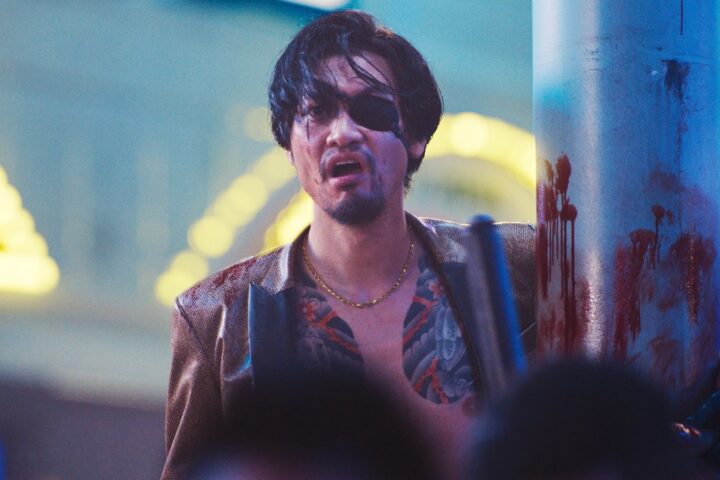Writer-director Yamazaki Takashi’s Godzilla Minus One begins on an island outpost in 1945, as kamikaze pilot Kôichi Shikishima (Kamiki Ryûnosuke) makes an impulsive choice to feign technical issues so he can avoid carrying out his suicidally nationalist duty. To him, living in shame is preferable to dying for glory, though the airman’s decision fatalistically coincides with the first appearance of a certain ravenous reptilian, who devours his way through a troop of aircraft mechanics while Kôichi cowers just out of sight.
Is Gojira, a.k.a. Godzilla, a manifested consequence of one man’s craven tendencies, or a symptom—as he often is in the decades-long series of films in which he appears—of some larger sociopolitical unease? This iconic movie monster began and often serves as a metaphor for deep-seated fears of nuclear testing and warfare, but in Godzilla Minus One he proves little more than a gargantuan antagonist, which is good enough for what Yamazaki sets out to do.
Any disappointments primarily stem from the film having to follow Anno Hideaki’s Shin Godzilla, a Fukushima-alluding cautionary fable inventively fused with a Thick of It-esque bureaucracy satire. Yamazaki, though, certainly gives himself as potentially potent a template, setting Godzilla Minus One mostly in the aftermath of World War II as Japan is at its cultural and economic lowest, and any sustainable future seems a pipe dream.
Kôichi comes home from the battlefield to find his family vaporized and his neighbors shunning him for his spinelessness. He quickly connects with a homeless girl, Noriko (Hamabe Minami), and an abandoned child, Akiko (Nagatani Sae), who they both adopt as their own. By 1947, Kôichi has restored his house and created a surrogate family that appears built to last. But he’s still haunted by his fearful first encounter with Godzilla. To assuage his guilt, he teams up with a ragtag bunch of navy men, as well as a former weapons engineer, Kenji (Yoshioka Hidetaka), to clear the waters near Tokyo of the ship-immolating mines left over from the war years.
Little do Kôichi and his companions know that everyone’s favorite bulging-thighed behemoth has been nuked by the American Army at Bikini Atoll in the South Pacific, with the blast quadrupling him in size and making him effectively indestructible. Of course, Godzilla is headed right for Tokyo, so given Japan’s defanged military capabilities, it’s up to science, in-the-moment ingenuity, and survivalist gumption to save the day.
The larger theme of Yamazaki’s script is the will to live through the worst of circumstances, and how that ethos evolves from Kôichi’s singularly mutinous act in the film’s first scenes to a mutually motivating force by the end. As one man rises from the wartime rubble, so does all of Japan—a lovely sentiment that Godzilla Minus One strains to fruitfully realize.
Unlike Anno’s expert balance of Shin Godzilla’s many disparate and seemingly incongruous elements, Yamazaki allows spectacle to trump all else, his characters becoming little more than pawns in a chomp-and-stomp game of whack-a-mole. Not that there’s anything wrong with that when the spectacle is as impressive as it is in Godzilla Minus One.
Two set pieces in particular stand out. In the first, Godzilla swims after Kôichi and his crew’s craft like a steroidal Jaws, every bullet proving ineffective, and a jaw-rending incendiary device easily shrugged off given the creature’s rapid healing abilities. In the second, Big G takes an afternoon stroll through Tokyo’s Ginza district, flattening fleeing citizens underfoot, razing buildings with claw and tail, and tossing around train cars like a toddler would their toys. And this latter sequence culminates with a jaw-dropping display of Godzilla’s blue-tinged atomic breath, the cold-blooded colossus silhouetted against an ever-expanding mushroom cloud as an already deeply anguished metropolis is further devastated.
For all the unbridled destruction, Godzilla Minus One remains perversely light and fun, a Roland Emmerich-like disaster flick helmed by an actual talent. Yamazaki’s conception of Godzilla is especially inspired, most notably in full profile shots where the beast moves eerily between the man-in-suit herky-jerkiness of Honda Ishirô’s 1954 classic Godzilla and a more modern motion-captured smoothness—a Brobdingnagian superstar cast from the molds of multiple eras. The human drama may pale in comparison to the titan roaring calamitously overhead, but the audience’s collective lizard brain will still be more than satiated.
Since 2001, we've brought you uncompromising, candid takes on the world of film, music, television, video games, theater, and more. Independently owned and operated publications like Slant have been hit hard in recent years, but we’re committed to keeping our content free and accessible—meaning no paywalls or fees.
If you like what we do, please consider subscribing to our Patreon or making a donation.




